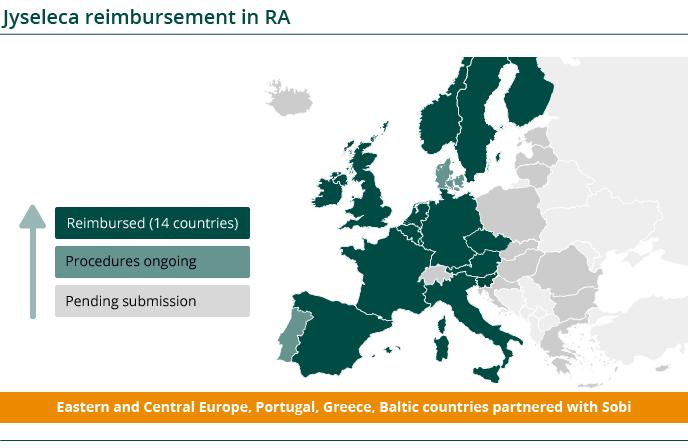institutional investors domiciled in the United States, excluding Gilead Sciences, Inc., or Gilead. We estimate that shares were held in the United States by approximately 175 institutional holders of record, excluding Gilead Sciences, Inc., or Gilead. As of March 15, 2022, there were 13,552,727 ADSs outstanding, each representing one ordinary share, and in the aggregate representing approximately 20.7% of our outstanding ordinary shares. The actual number of holders is greater than these numbers of record holders, and includes beneficial owners whose ADSs are held in street name by brokers and other nominees. This number of holders of record also does not include holders whose shares may be held in trust by other entities.
On February 3, 2022, EcoR1 Capital LLC filed a Schedule 13G with the SEC to report that as of January 27, 2022, it held 5.2% of the outstanding shares of Galapagos as of January 27, 2022. EcoR1 Capital LLC thus crossed above the 5% threshold of Galapagos voting rights by purchase of voting securities on January 27, 2022.
On November 2, 2021, Van Herk Investments BV filed a Schedule 13D with the SEC to report that, as of November 2, 2021, it held 7.1% of the outstanding shares of Galapagos as of September 20, 2021.
On May 10, 2021, The Capital Group Companies, Inc. filed a Schedule 13G with the SEC to report that, as of April 30, 2021, it held 4.5% of the outstanding shares of Galapagos as of April 30, 2021. The Capital Group Companies, Inc. thus crossed below the 5% threshold of Galapagos voting rights by disposing of voting securities on April 30, 2021.
On February 26, 2021, we received a transparency notification from The Capital Group Companies, Inc., who notified that it holds 9.91% of the outstanding Galapagos shares. The Capital Group Companies, Inc. thus crossed below the 10% threshold of Galapagos’ voting rights by disposing of voting securities on February 22, 2021. On February 5, 2021, we received a transparency notice from The Capital Group Companies, Inc., that it held 10.03% of Galapagos shares. The Capital Group Companies, Inc. thus crossed above the 10% threshold of Galapagos’ voting rights by purchase of voting securities on 22 January 2021. Capital Group controls Capital Bank & Trust Company and Capital Research & Management Company through its direct subsidiary Capital Group International, Inc. (“CGII”), controls four CGII investment management companies (Capital International, Inc.; Capital International Limited, Capital International Sàrl; and Capital International K.K.), which all together hold 6,563,320 of Galapagos’ voting rights, consisting of ordinary shares (6,559,874) and equivalent financial instruments (right to recall lent American Depository Shares) (3,446), which represents 10.03% of Galapagos’ 65,411,767 outstanding shares as of March 15, 2021. On January 6, 2021, we received a transparency notice from Gilead Sciences, Inc., who notified that certain changes occurred in the chain of intermediary companies through which Gilead holds its shares in Galapagos, as a result of which Gilead holds its shares in Galapagos as of December 31, 2020 through its direct subsidiary Gilead Biopharmaceutics US, LLC, which through Gilead Sciences Ireland UC controls Gilead Therapeutics A1 Unlimited Company, which in turn holds 16,707,477 of Galapagos' voting rights, consisting of 16,707,477 shares (unchanged). Those 16,707,477 shares represent 25.54% of Galapagos' 65,411,767 outstanding shares as of March 15, 2021.
On January 7, 2020, we received a transparency notice from Gilead Sciences, Inc., who notified that certain changes occurred in the chain of intermediary companies through which Gilead holds its shares in Galapagos, more specifically that (i) on December 27, 2019, Gilead Biopharmaceutics US, LLC, a direct subsidiary of Gilead Sciences, Inc., acquired control over Gilead Biopharmaceutics Ireland UC, and that (ii) on December 28, 2019, Gilead Sciences Ireland UC, a direct subsidiary of Gilead Biopharmaceutics Ireland UC, acquired control over Gilead Therapeutics A1 Unlimited Company, an indirect subsidiary of Gilead Sciences, Inc., who holds 16,707,477 shares, representing 25.84% of our outstanding shares as of March 15, 2020.
On November 13, 2019, we received a transparency notification from Wellington Management Group LLP, who indicated that, following a disposal of ordinary shares, ADRs and equity swaps, the remaining Galapagos shares and equivalent financial instruments held by its entirely-controlled subsidiary Wellington Management Company LLP crossed below the 5% threshold of Galapagos’ voting rights. On November 11, 2019, we received a transparency notification from Gilead Sciences, Inc., who notified that Gilead Therapeutics A1 Unlimited Company, an indirect subsidiary of Gilead Sciences, Inc., held 16,207,477 of Galapagos' voting securities as a result of subscribing to a capital increase in the framework of the exercise of the Initial Warrant A on November 6, 2019, representing 25.10% of our then outstanding 64,571,622 shares. On October 22, 2019, we received a transparency notification from Wellington Management Group LLP, who indicated that, following a disposal of ordinary shares, the remaining 3,079,573 ordinary shares held by its entirely-controlled subsidiary Wellington Management Company LLP represented 4.97% of the then outstanding Galapagos shares and thus, with the ordinary shares portion of its total position, crossed below the 5% threshold of our voting rights on October 8, 2019. In addition, through its wholly owned subsidiary Wellington


















